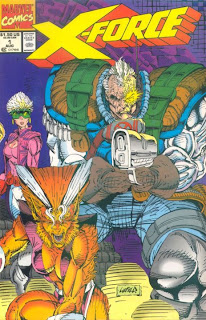You know, I thought I'd said all I had to on this subject, but there are a couple of things I still need to get off my chest.
"I should start this discussion by saying that there isn’t anything wrong with enjoying comic books, even as an adult. They can be fun, for sure. But to imagine that comic books offer anything other than lowgrade entertainment is laughable. Comics are not high art (in fact, most of them are horrible even as graphic art) and they most certainly do not equal anything of the sort of deep, consequential literature. Comics are a childish, formulaic, lowest common denominator form of entertainment. It doesn’t make them evil or useless or bad necessarily. It just makes them low-end, fun. They are nothing to be taken seriously. If you are someone that lives for your next comic, or you want to claim that comic books are 'art' worthy of serious consideration… you need to get out of your parent’s basement a little more often. Still, they can be fun if treated as the mindless entertainment that they are. Call it a guilty pleasure, something that for a few hours or so might help you take your mind off the harsh glare of reality."
Even though, if I really had to, I would classify myself as a liberal and I am registered to vote as a Democrat, I'm not really all that political. I am, however, passionate about the comics art form. Thus, even more than his trite, mean-spirited, and false generalizations about liberals, which are really just boilerplate conservative talking points and not even really worth acknowledging, let alone taking time to refute, it is the above quoted passage and others like it from
the recent bloviating by right-wing nutbar Warner Todd Huston over a minor detail in one panel of a recent issue of Captain America which I
wrote about on Sunday that really raises my hackles.
Hanging out, as I do, mostly with fellow cartoonists, comics readers and other similarly enlightened sorts, it can be easy for me to think that comics' decades long struggle for mainstream acceptance as a serious art form and entertainment medium has finally been won. After all, movies based on comics are among the top grossing films of the past decade, and the film adaptation of Harvey Pekar's
American Splendor became an indie sensation when it debuted at the Sundance Film Festival; mainstream bookstores feature burgeoning graphic novel sections featuring everything from the collection of the latest Batman storyline to alternative titles from publishers such as Top Shelf and Fantagraphics; and
Time magazine even named a graphic novel, Alison Bechdel's
Fun Home, as the best book of 2006.
Given all that, its somewhat of a shock when I read something like Huston's piece and find myself slapped in the face with all the same myths and prejudices about comics that are almost as old as the medium itself. The first anti-comic book rant to gain national attention was a piece by children's book author
Sterling North entitled "A National Disgrace" which first appeared in the
Chicago Daily News in May of 1940 and was subsequently reprinted in dozens of papers nationwide. Personally, I think North was just jealous because comics were read by more kids than his books, but that's way off topic, not to mention too simplistic an explanation.
The age old charges against comics are all there in one big, odious lump in Huston's paragraph: the idea that all comics, by their very nature, are poorly drawn and barely written trash paired with the implication that comics are, and can only ever be, fit only for children and illiterates (later on he urges comics fans to read "real books" once in a while); and the stereotype that adults who read comics are socially inept losers who still live with their parents and are most likely still virgins. I'm surprised he didn't include the Wertham inspired charges that comics turn children into criminals and/or homosexuals.
Given Huston's spouting of these hoary old cliches as if they were gospel truth, its quite easy to forgive
Robot 6 blogger Carla Hoffman for assuming, as she seems to in her post
"An Open Letter To Warner Todd Huston", that he had never before actually bothered to read a comic book. Nor, for that matter, despite his anemic claims to have been a comics collector during his misspent youth, does it appear based on what he writes that's he's ever even met anyone who's ever read a comic book.
I suppose that Huston isn't the only one still clinging to these ridiculous, outdated and provably false ideas, but fortunately their numbers seem to be dwindling.
It seems to me that if you want to assume that comics are just for children, its not the political meaning of the panel that offended Huston that should bother you. The panel depicts a protest rally where one of the signs reads, "Tea Bag the Libs Before They Tea Bag You!" which to Huston indicates that the panel is meant to depict members of the so-called Tea Party movement and paint them as rascists. What really should bother someone worried about what the impressionable kiddies might be reading is that the message on the offending sign is, in fact, truly offensive. It is clearly a reference to the pornographic connotation of the term
"Tea Bag," which could lead to some embarrassing moments when Junior asks what the sign means. Now, I'm not advocating for the return to full power of the Comics Code, but if Marvel were still submitting their books to the Code Authority, this whole flap would never have happened, as there's no way they would have let the book go out with that phrase in it.
Another thing that bugs me about Huston's rant , and doesn't concern either his political views or his attitudes towards comics, is the hypocrasy he exhibits when he chides certain of his critics for misspellings and poor grammar in their comments, while his post is riddled with examples of the same.
One particularly ticked off blogger takes Huston to task for his misuse of punctuation, and you'll notice that in the quote with which I led off this post, he writes "low grade" as one word, and there are many more examples scattered throughout his text like Easter eggs for anyone obsessive enough to hunt for them. Because of the dash-it-off-and-hit-send nature of most blogs, I'm willing to forgive a certain amount of typos, misspelled words and grammatical errors, UNLESS the writer seeks to act as a self-appointed grammar cop, criticizing the errors of others. If you're going to do that, you'd damn well better make sure that your own glass house is in order. That's why you can be assured that I will have thoroughly proofread this post before you read it.
Finally, I want to address his BS about the so-called "first rule of journalism." According to Huston, Hoffman supposedly violated said rule by not attempting to contact him before writing her piece. Later on, however, responding to charges of bias, he admits that both his and Hoffman's columns are opinion pieces, and, therefore, by their very nature, biased. That is certainly true, and it is also why opinion writing is NOT journalism, and thus not subject to the "first rule," which, by the way, I'd never heard of before, and I was a Communications major in college, so I studied journalism.
This, of course, is just my opinion, and now that I've expressed it, its time to move on to other things.
By the way, and I'm not this if this manufactured controversy had anything to do with it, but when I was at the Laughing Ogre, the comics shop just down the street from my apartment, I noticed that they were sold out of
Captain America #602.

















